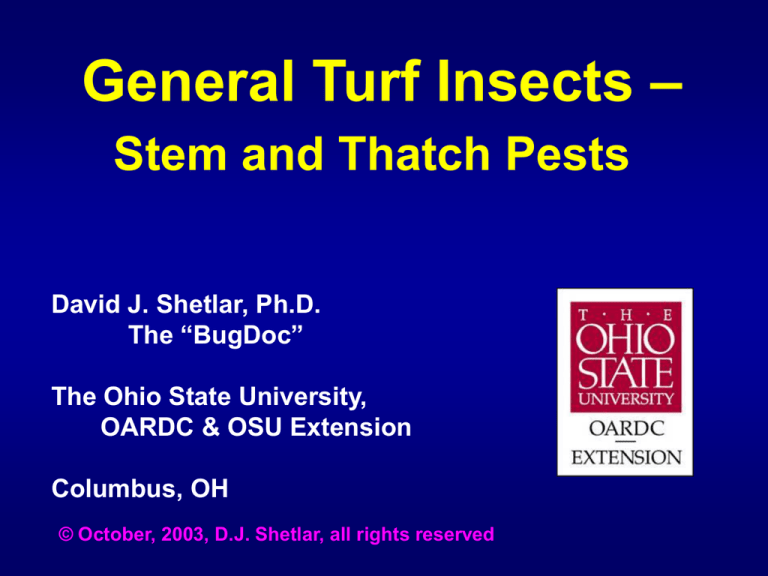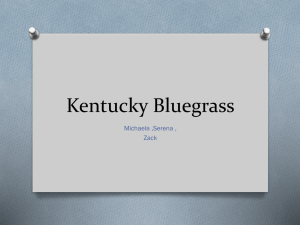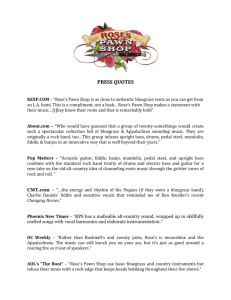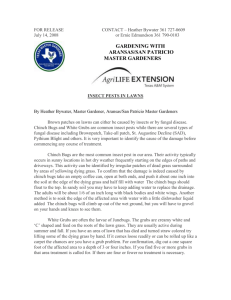
General Turf Insects –
Stem and Thatch Pests
David J. Shetlar, Ph.D.
The “BugDoc”
The Ohio State University,
OARDC & OSU Extension
Columbus, OH
© October, 2003, D.J. Shetlar, all rights reserved
Stem & Thatch Pests
Chewing Pests
Sucking Pests
(feed on stems, clippings & leaves)
Cranberry Girdler
Crane Flies
March Flies
(borers of stems & crowns)
Billbugs
Annual Bluegrass
Weevil
Frit Fly
Chinch Bugs
Spittlebugs
Mealybugs
Scales
Cranberry Girdler
(=subterranean sod webworm)
Chrysoteuchia topiaria (Zeller)
Notes: This pest is technically a crambid type sod webworm, but it has
a very different larval behavior. The larvae tend to feed on the stems
and crowns of turf, when large, rather than feeding on leaves. Infested
turf tends to die in irregular patches, often at the time that white grubs
would be causing similar damage. In thick turf, the dead canopy can
be pulled back to reveal considerable amounts of straw colored frass
pellets on the soil/thatch surface. With grubs, the entire turf canopy
with the thatch can be pulled back to reveal grubs in the soil/thatch
interface.
Cranberry girdler adults are small
crambids with distinctive bands of
silver scales along the wing tip. The
adults tend to fly from late June
through much of July. There is only
one generation per year.
Cranberry girdler larvae
have the typical
sclerotized plates that
all sod webworms have,
but the plates are the
same color as the rest
of the integument.
Therefore, the typical
spots are not apparent!
Cranberry Girdler Distribution
Cranberry girdler most commonly reaches pest status in the northern
part of this range. It is also a common pest in the Canadian Provinces.
Damage is a perennial occurrence in Utah, Washington, Oregon,
Wisconsin and Minnesota.
Crane Flies
(=leatherjackets)
European Crane Fly, Tipula paludosa (Meigen)
European Marsh Crane Fly, Tipula oleracea L.
Native Crane Flies, Tipula & Pedicia spp.
Notes: The European and European marsh crane flies are imported
pests that are well established in British Columbia, Washington and
Oregon. Recent reports indicate that either or both species are also in
the eastern Canadian Provinces and perhaps bordering states. Native
species of crane flies can also be found infesting turf, especially turf
that has been damage from snow mold or overly wet soils. The larvae
are often called leatherjackets because of their tough exoskeletons,
and the adults are called daddy-long-legs in Europe.
Adult crane flies tend to emerge
in the fall or spring, depending
on the species. The European
crane fly emerges in September
and October. The large
mosquito-shaped flies often
scare people, but they have nonfunctioning mouthparts. Eggs
are usually oval and shiny black.
The larvae feed on grass blades,
clippings and thatch.
Most crane fly larvae
have gray to brown
bodies with conspicuous
caudal projections and a
black to dark brown head
capsule. Both the caudal
projections and head can
be withdrawn into the
body when the larvae are
disturbed.
Stem Borers
Billbugs
Annual Bluegrass Weevil
Frit Fly
Billbugs
Bluegrass Billbug, Sphenophorus parvulus
Hunting Billbug, S. venatus vestitus
Phoenician (=Phoenix) Billbug,
S. phoeniciensis Chittenden
Rocky Mountain (=Denver) Billbug,
S. cicatristriatus Fahraeus
Blugrass billbug adult
Hunting billbug adult
Denver billbug adult
Phoenician billbug adult
Billbug Distribution Maps
Bluegrass billbug
Phoenician billbug
Hunting billbug
Denver billbug
Billbug damage to lawn
© HDN
Bluegrass billbug adult on sidewalk
© HDN
Bluegrass Billbug
Adult and larva
Larva in crown,
note frass filled
stem.
The “Tug Test”
To detect and confirm
bluegrass billbug
activity, grasp suspect
stems and tug lightly.
If billbug larvae have
been feeding,
damaged stems will
break off easily.
Inspect the broken
stems for sawdust
like frass.
Bluegrass Billbug Life Stages
© HDN
small larva mature larva
fresh pupa
mature pupa
callow adult
mature adult
Most believe that billbugs have five to six larval instars. The first two or three
instars are usually small enough to burrow within stems, but eventually they have
to chew their way out and feed externally on crows, stems and rhizomes. When
ready to pupate, the mature larva burrows into the soil and forms a compact pupal
cell. The pupa is first cream colored and gradually turns a reddish brown at
maturity. Newly emerged adults often have this brown color and they are called
“callow adults.” Eventually, the adults turn blackish gray.
Bluegrass Billbug Life Cycle in Ohio
Notes: Bluegrass billbugs overwinter in the adult stage. The adults may hide in
taller grasses nearby the turf, along sidewalks, stone walls and building
foundations. Adults have also been found in thatch and old worm holes. When
the soil surface temperature reaches 68ºF, the adults become active – seeking
grass stems on which to feed, mating and laying eggs. Most females have mated
the previous fall, but they can mate again in the spring. Females seek the thickest
stems, often the seed stem, in which to excavate a hole and insert a bean shaped
egg. The eggs hatch in a week or more and the small larvae burrow up and then
down the stems, leaving the stems filled with sawdust like frass. By the third
instar, most larvae are too large to remain within the stems. They then feed in the
larger crowns or externally on the crowns, roots and rhizomes. Adults lay eggs
over a long period of time. Larvae mature from mid-June to early July at which
time they dig deeper into the soil to pupate. The pupal stage takes about two
weeks to complete and new adults are commonly found in mid-July into August.
Occasionally, summer adults will lay eggs for a partial second generation. Any
larvae or pupae that haven’t finished development by the time of the first freeze
appear to die. The adults are commonly seen walking about on sidewalks and
driveways in September and October.
Billbug control with pesticides uses one of two tactics – adult elimination before
egg lay and/or larval control. Surface insecticides applied in early May usually
eliminate sufficient adults to prevent damage. Larval control insecticides should
be applied from mid-May into early June. Billbugs can also be easily controlled
by using endophytic grasses.
1999 Ohio Billbug Curative
Treatment
Rate
% Control
Scotts 3.2% diazinon on 28-4-6
4.00
87.5
VIGRO 3.34% diazinon on 28-4-6
4.36
68.8
Ortho Diazinon (5%G)
4.36
58.3
Ortho Dursban (1%G)
0.87
16.7
0.2%G Bifenthrin
0.10
20.8
Intercept H&G (0.1% deltamethrin) 0.13
16.7
Spectricide 3X (0.25 permethrin)
0.27
45.8
MACH2 2LTI
1.50
20.8
appl - 11 Jun; Wooster, OH; read - 30 Jun(19DAT); 24.4 BBs/sq.ft. check
1999 Ohio Billbug Preventive
Treatment
Rate Date Appl % Control
DeltaGard 0.4SC
0.13
7 May
67
Merit 75WP
0.40
7 May
96
Scimitar 0.88GC
0.06
7 May
81
MACH2 2LTI
1.50
7 May
81
MACH2 2LTI
1.50
11 Jun
89
Meridian 25W
0.26
7 May
100
Meridian 25W
0.20
11 Jun
81
appl - 6May; Columbus, OH; read - 25June(48DAT); 32.0 adults/sq.ft. check
2000 Ohio Billbug Preventive Test
Treatment
Rate
% Control
Diazinon 3.34G
4.36
92
Diazinon 3.2G
4.0
95
Talstar PL 0.2G
0.1
69
Talstar Fert 0.2G
0.1
72
Tempo 0.1G
0.13
67
appl - 16 May; Wooster, OH; read - 5July; 24.7 larvae/sq.ft. check
2001 Ohio Billbug Preventive Test
Treatment
Rate
% Control
Talstar 0.147G
0.2
64
Talstar 0.086G
0.1
43
Tempo 0.1G
0.087
50
Permethrin 0.25G
0.272
32
Diazinon 3.2G
4.0
68
Merit 0.5G
0.4
86
MACH2 1.5G
1.5
36
appl - 24 May (late preventive); Wooster, OH;
read - 12July; 17.8 larvae/sq.ft. check
Annual Bluegrass Weevil
Listronotus (=Hyperodes) maculicollis
This weevil was included in the genus Hyperodes for many years and
many still refer to this pest as the “Hyperodes weevil.”
Annual Bluegrass Weevil Distribution
H. D. Niemczyk
Annual bluegrass weevil (left to right): adult, pupa, annual bluegrass stem, larva.
Notes: The annual bluegrass weevil is so named because it attacks annual
bluegrass, Poa annua. This pest is found in northeastern North America, including
most of the New England States and eastern Canadian Provinces. Its damage is
most evident where Poa annua is intensively managed (e.g., golf course greens and
tees, lawn bowling ranges, and lawn tennis courts). In the past, it was stated that
this pest exclusively feeds on P. annua, but recent investigations indicate that the
larvae will also damage bentgrass, especially when bentgrass is mixed with the P.
annua.
The adult weevils feed on the margins of grass leaves, causing a ragged
appearance and general thinning of the turf cover. This can often be mistaken for
disease. Adults overwinter in leaf litter, especially pine needle duff, surrounding
managed turf. In early spring, when Forsythia first blooms to the time that
flowering dogwood begins to bloom, the adults move back into the turf to feed and
begin laying eggs. Females insert small bean shaped eggs into leaf sheaths and
the typical weevil larvae burrow into the stems. The larvae move down to the crown
and can entirely consume the crown and surrounding tillers. By early June, the
first generation is completed and new adults can be seen by mid to late June. Over
most of its range, a second generation is completed. The first generation is usually
the most damaging one, but if there is a cool, moist summer, the second generation
can cause significant damage also.
H. D. Niemczyk
Annual bluegrass weevils commonly kill Poa annua at the time that it may
normally die (the true annual forms) or go into summer dormancy.
H. D. Niemczyk
Early damage from annual bluegrass weevils can look like disease or other malady.
H. D. Niemczyk
Close up of annual bluegrass weevil damage to Poa annua on green.
H. Tashiro
Annual bluegrass weevil larvae feed at the crown, causing the top portion of the
plants to die.
Annual Bluegrass Weevil in NY
Redrawn from P. Vittum & H. Tashiro, 1987 data
Annual Bluegrass Weevil in NY
(with control windows)
Adult Control
Curative Control
Severe Damage
Redrawn from P. Vittum & H. Tashiro, 1987 data
Adulticide controls are usually applied
from the time that Forsythia is in full
bloom to the time that flowering
dogwood begins to bloom. This
technique uses a technique called
phenological indicators – coordination of
pest activity with visual cues given by
various plants.
Using these phenological
indicators only works for the
first generation. Second
generation adults and larval
populations have to be
monitored using visual
inspections of the turf.
ABG Weevil Management
•
Sampling (watch for adult weevils when
forsythia is in bloom)
•
Keep Records (which tees & greens get
hit and damaged?)
•
Preventive Applications (recommended –
Dursban or pyrethroid when adults move)
•
Curative Applications (not very effective)
Ranked Efficacy of ABGW Insecticides
(used as preventives) - 1989 – 2000a
OPs
&
Carb
a
Insecticide
rate
ave
lb.ai./a. % control # tests
Bendiocarb
(=Turcam)
2.0
3.0
28.6
78.4
13
5
Carbaryl
(=Sevin)
8.0
55.6
2
Chlorpyrifos
(=Dursban)
1.0
2.0
53.6
73.3
7
32
Isofenphos
(=Oftanol)
2.0
51.2
7
Trichlorfon
8.0
(=Dylox, Proxol)
33.5
7
Data from ESA publications (1989-2000) using annual bluegrass weevil data where timing of application was stated
to be “preventive.”
Ranked Efficacy of ABGW Insecticides
(used as preventives) - 1989 – 2000a
Pyrethroids
a
Insecticide
rate
ave
lb.ai./a. % control # tests
Bifenthrin
(=Talstar)
0.05
0.1
88.2
95.5
12
24
Cyfluthrin
(=Tempo)
0.14
87.6
15
Deltamethrin
(=DeltaGard)
0.06
0.13
62.0
90.0
6
11
lam-Cyhalothrin 0.03
(=Scimitar)
0.06
92.8
97.3
8
8
Data from ESA publications (1989-2000) using annual bluegrass weevil data where timing of application was stated
to be “preventive.”
Ranked Efficacy of ABGW Insecticides
(used as preventives) - 1989 – 2000a
NeoNs
&
IGR
a
Insecticide
rate
ave
lb.ai./a. % control # tests
Halofenozide
(=MACH2)
1.5
2.0
48.5
41.1
10
8
Imidacloprid
(=Merit)
0.3
0.4
39.7
59.7
23
7
Imidacloprid +
Cyfluthrin
0.3
0.14
87.4
12
Thiamethoxam
(=Meridian)
0.2
0.26
Data from ESA publications (1989-2000) using annual bluegrass weevil data where timing of application was stated
to be “preventive.”
Frit Fly
Adult frit flies are commonly
attracted to light colored
surfaces like golf balls, caps, tee
markers, etc.
Close up of the frit fly
on a grass blade.
Notes: There are several species of flies in the family Chloropidae that have
larvae that burrow into the stems of grasses and small grain crops. This often
damages the seed stems, causing the developing seeds to wither. These
withered seeds are called frits, which is where the name frit fly comes from.
The true frit fly, Oscinella frit (Linnaeus), is a native of Europe, but it has been
spread around the world. Other chloropids may also be infesting turf.
Young frit fly larvae overwinter within a grass stem. In the spring, the larvae
continue to burrow down the stem, killing everything outward from where they
are feeding. The affected stems first turn yellow and then brown. Up to four
generation can occur during a season, and adults are most common in midMay, late June, late July and mid-September, in Ohio.
The adult flies are attracted to light colored surfaces and often alight on golf
balls, thereby causing the golfer to lose concentration.
Damage is often misdiagnosed as disease or drought problems. Only careful
inspection of stems that are turning yellow will reveal whether the malady is
being caused by frit fly maggots or some other reason.
Chinch Bugs
Hairy CB, Blissus leucopterus hirtus
Common CB, B. l. leucopterus
Southern CB, B. insularis
Buffalograss CB, B. occidus
Hairy chinch bugs in thatch
Hairy chinch bug adults long wing & short wing forms
Hairy Chinch Bug Damage to Lawn
Chinch Bug Distribution Maps
Hairy chinch bug
Common chinch bug
Southern
chinch bug
Hairy Chinch Bug Life Stages
egg 1st
2nd
3rd
4th
instar nymphs
5th
normal winged
adult
short winged
adult
Hairy Chinch Bug Life Cycle in Ohio
Populations of the Hairy Chinch Bug 2004
# of insects/ sq. ft
April,
May,
June,
July,
August, September, October
250
250
200
200
150
150
100
100
50
50
0
0
April,
May,
June,
July,
August, September, October
weeks
Variable
Adults
Nymphs
Eggs
Notes: The hairy, common and buffalograss chinch bugs appear to overwinter as
adults. In the spring, the adults seek out suitable places to feed and lay eggs. For
the hairy chinch bug, most of May is spent laying eggs and the nymphs develop
from late May into early July. The later instar nymphs cause severe damage by
clogging up the vascular bundles within stems and even at the crown. Damaged
crowns often die.
Chinch bug populations are highly regulated by rainfall and moisture. The small
nymphs are susceptible to drowning in saturated thatch and all stages appear to be
susceptible to the white fungus of insects, Beauveria. In normal years, a second
generation is produced in late July through August. Occasionally, this second
generation can be larger than the first with significant turf damage appearing in late
August to mid-September.
In Canada, the hairy chinch bug completes only one generation with damage being
most evident in July and August.
Where turf is at risk of chinch bug damage (e.g., previous experience indicates that
chinch bug damage is a regular occurrence), applying controls to eliminate
overwintered adults is a useful strategy. Otherwise, if visual inspection in early to
mid-June and again in August reveals numerous chinch bugs and early signs of
damage, curative insecticide applications are in order. Chinch bugs are rarely a
problem in regularly irrigated turf or in turf containing endophytes.
Hairy chinch bug life cycle in Ohio with damage and control windows
2001 Ohio Hairy Chinch Bug Control
% Control
7DAT
14DAT
Treatment
Rate
Merit 75WP
Exp NN
Exp NN
Tempo Ultra
Tempo 20WP
0.3
0.3
0.4
0.1
0.2
92
90
78
83
22
96
87
81
63
0
Talstar SC
0.1
98
98
appl. 30 Aug., Springboro, OH; 943.5 & 418.6 hcb/sq.ft. checks @ 7, & 14 DAT
Southern chinch bugs often damage St.
Augustine grass, but they can also infest
bermudagrass and zoysia. In the midwestern
states, the buffalograss chinch bug seems to be
the most common species attacking zoysia.
To the untrained eye,
southern chinch bug
damage often appears to
be drought stress or
improper irrigation
distribution. The only
way to tell is to look in the
thatch for chinch bug
nymphs and adults.
2000 FL Southern Chinch Bug Control
% Control
6DAT
Treatment
Rate
Talstar PL 0.2G
“
DeltaGard 0.1G
“
Dursban 1G
0.10
0.26
0.09
0.13
1.00
99
100
69
Meridian 0.33G
0.20
98
86
86
appl. 7 Sep., Boca Raton, FL; 515.1 scb/sq.ft. checks @ 6 DAT; St. Augustinegrass
Notes: There are numerous other insects that commonly inhabit the turfgrass
stem and thatch zone.
The twolined spittlebug is commonly found in the Gulf States where it can
severely damage centipedegrass and occasionally infests bermudagrass. The
nymphs make characteristic spittlemasses that can annoy anyone waking across
the infested turf. The nymphs can also clog up the grass vascular system. Adult
twolined spittlebugs occasionally damage ornamental plants, especially some
species of holly.
There are several dozen species of mealybugs and scales that infest turfgrasses.
The rhodesgrass mealybug appears to be the most widely distributed, especially
in low maintenance southern turf (especially bermudagrass). When well
fertilized, watered and mowed, this mealybug is rarely a problem.
The bermudagrass scale (an armored scale that infests bermudagrass stolons
and crowns) and the European bluegrass scale (a soft scale that infests
Kentucky bluegrass and perennial ryegrass) are two of the most commonly
encountered scales of turfgrasses. The bermudagrass scale damage is most
commonly mistaken for drought damage. The bluegrass scale produces
considerable honeydew that is attractive to bees, ants and wasps. The crawlers
are bright pink and can become a real annoyance when they crawl over
surrounding structures.
Twolined spittlebugs attack
centipedegrass, bermudagrass
and St. Augustinegrass.
Adult on St. Augustinegrass blade.
Nymph pushed out of
spittlemass located at
base of grass stems.
Rhodesgrass Mealybug
The mealybug
nymphs settle at
the bases of leaf
blades and under
leaf sheaths. As
they mature, they
develop an anal
wax tube through
which they
excrete their
honeydew. This
mealybug can be
found on many
grasses, but is
most often a
problem on
bermudagrass.
Bermudagrass
Scales and
Damage
Bluegrass Scale
The bluegrass scale is
of European origin.
The scales look much
like the lecanium soft
scales that infest trees.
Females produce a
waxy cottony material
in which they deposit
their eggs. The
crawlers are a bright
pink color and
hundreds per square
foot can become a
nuisance when they
are crushed and stain
clothing. At present,
this scale is found in
areas surrounding
Lake Erie.





